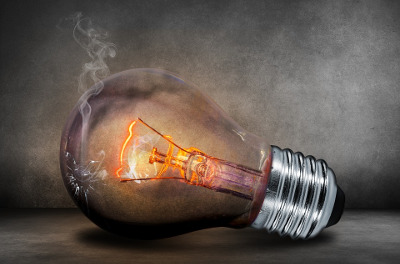
Light bulbs have a finite life and when the time comes for their disposal, you may be a little unsure of the best way to proceed. Reduce, reuse and recycle are the bywords of the waste industry today, so how can you follow their lead when your light bulbs have seen better days?
It really depends on the type of light bulb you have. Although incandescent light bulbs can no longer be purchased here in the UK there will still be plenty of you that have them in your homes. Some of you may even have a bit of a stockpile.
We know of several people who rushed down to the supermarket when they realised they wouldn’t be able to buy them anymore.
Unfortunately, this type of bulb is not recyclable and can only be disposed of with your household waste. And you definitely can’t reuse them, unless you know something we don’t. The reason these old-fashioned light bulbs can’t be recycled is that they’re made of different glass and contain wire made from tungsten metal. An analogy is the recycling of window glass.
To prevent injury to the waste collector or yourself, it’s sensible to wrap the spent light bulb in newspaper or bubble wrap.
How to Dispose of Old Light Bulbs Properly
When the time comes to buy into the idea of energy-saving light bulbs, and that day will come, you can, in fact, recycle these light bulbs in a couple of ways. Energy-efficient light bulbs are a kind of fluorescent lamp and the bulbs can be taken to your local recycling centre, where they will dispose of them correctly.
Alternatives to Recycling Centres
- Some high street stores, for example, Tesco and Ikea, have collection points enabling to you save on making a special trip to the local recycling centre. You can dispose of your old light bulbs while doing the weekly shopping.
- If the bulb is broken you’ll have to contact your local council as it is now classed as hazardous waste. It is their duty to provide facilities for the safe disposal of household hazardous waste.
- Whatever you do, don’t throw them in your normal waste as they can damage the environment. The reason they generate light so efficiently is due to the small amount of mercury they contain.
Businesses also have a responsibility to correctly dispose of their energy-efficient light bulbs safely and correctly. You probably didn’t realise that the contents of one fluorescent tube have the potential to pollute more than 30,000 litres of water. Many waste collection companies offer suitable receptacles in which to keep your old light bulbs and will arrange to come and empty it as part of their waste collection service. The tubes that have been collected are sent for recycling. This involves refining the mercury element for reuse in the manufacture of another lighting.
LED light bulbs don’t contain any dangerous chemicals and can be disposed of with your normal household waste. Some of these are now manufactured using materials that are recyclable, so it’s a good idea to check the packaging to clarify whether there is a better form of disposal.
Image source: www.flickr.com






A team of scientists at the University of Cambridge has found a puiorctodn method that could lead to cheaper LEDs within a few years.LED lights are a technology that most EcoGeeks are hoping to see in widespread distribution. LED lights can be even more efficient than compact fluorescent lights, and they don’t contain mercury like CFLs do. LEDs also have a much longer lifespan, and can operate for 10 times longer than fluorescents and 100 times longer than incandescents. They’re just still a little expensive, up to $100 / bulb.One problem with producing LEDs is that the substrate typically used for LEDs is sapphire, rather than silicon, which can be used for many other semiconductors. Many LEDs are made from gallium nitride which is grown into crystals at a temperature of around 1000 C (1832 degrees F). Unlike other electronic components, which can be fabricated on a silicon base, gallium nitride shrinks faster than silicon when it cools, which leads to cracking and failure. Sapphire has a rate of shrinkage and cooling that closely matches the LED compounds, which makes it a suitable substrate.The University of Cambridge team’s development is a method to make LEDs incorporating aluminum gallium nitride, which shrinks much more slowly as it cools, and allows the puiorctodn of LEDs on silicon wafers like other components. A 15-centimetre silicon wafer costs just $15 and can accommodate 150,000 LEDs making the cost per unit tiny. With the commercialization of this process, inexpensive LEDs may become available, and a superior alternative for lighting can help save billions of kilowatt hours of electrical demand.via: New Scientist